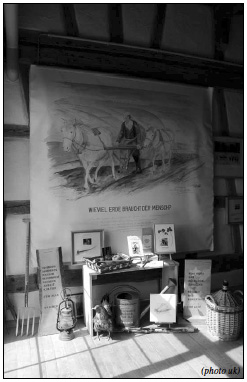Comprehend more precisely
Comprehend more precisely
Ethics and culture – Leo Tolstoy, Ilya Repin and the “Travelling Artists”
cc. From 13 to 27 September 2015 the anniversary exhibition „10 Jahre Kunst Schwyz” (10 Years of Art Schwyz) is on display on the site of the Old Cement Plant in Brunnen. Since 2005 the exhibition “Art Schwyz” has been the annual culmination point for the association of artists of the same name from Central Switzerland. The association was founded in 1992 as a counter-position to the art scene backing and seeking to profit from the destructive Switzerland bashing – “700 years are enough” – in the context of the World Exhibition 1991. Urs Knoblauch spontaneously joined this countermovement and became a founding member of the artists’ association in the Canton of Schwyz.
As a part of this year‘s exhibition, he presents his artistic tribute to Leo Tolstoy and Ilya Repin and the Russian travelling artists. In the present work of art (installation) by Urs Knoblauch, the important issues of social justice, agriculture and food security are represented through the example of the two great Russian artists Leo Tolstoy (1828–1910) and Ilya Repin (1844–1930). The large-format acrylic painting of 2011 (215 x 195 cm, on canvas, to be rolled up like maps or school pictures) takes up the motif “Tolstoy plowing” (1887) and his famous short story “How Much Land Does a Man Need?” Various everyday items, objects, studies and a photo-text work referring to Chingiz Aitmatov (1928–2008) from 2009 complement the theme.
With his work, the artist also hints at the original meaning of the term culture from Latin “agricultura”. “However, meanwhile, one has forgotten that nourishments of corn, vegetables, and fruit raised from the soil by one’s own labour is the pleasantest, healthiest, easiest, and most natural nourishment, and that the work of using one’s muscles is as necessary a condition of life as is the oxidation of the blood by breathing.” (Leo Tolstoy, “What is art?”)
(Kopie 1)

In the 19th century democratisation was strengthened, good culture was to be made available to all people. Realism developed into a common sense visual language. Fourteen young Russian artists turned away from St. Petersburg Academy in 1863. They sought their motives in everyday life, in direct contact with the population and especially with the oppressed peasantry. In 1870, they founded the “Cooperative of Travelling Exhibitions” and dealt extensively with the ethical and moral tasks of art and culture. The “Peredwishnikis’ (travelling artists) created Enlightenment art, took their “travelling exhibitions” from cities to remote rural regions and praised the people and their agricultural work. The cooperative was joined by numerous significant painters of Russian Realism. A central personality was llya Repin, who was a friend of Leo Tolstoy. For decades, the “traveling painters” were highly influential. Changes in society, arbitrariness and formalism led to the dissolution of the “Peredwishniki” in 1922.
The art work is to be thought-provoking, how power politics, greed, wars, colonialism and social misery can be overcome. The whole world community needs more ethics, social solidarity and non-violent conflict resolution. Europe must go back to its humanist culture substance in order to contribute to a peaceful and equitable coexistence of all people. Everybody, especially the artists are invited to contribute. Switzerland made a major contribution in 2014 by publishing a joint issue of two stamps under the slogan “Partnership – 200 years of diplomatic relations between Russia and Switzerland”.
Urs Knoblauch: <link http: www.kultur-und-frieden.ch>www.kultur-und-frieden.ch
Exhibition opening hours:
Urs Knoblauch’s Installation “Ethics and culture – Leo Tolstoy, Ilya Repin and the Travelling Artists” can be seen in the anniversary exhibition “10 years of Art Schwyz” on the site of the Old Cement Plant, Industriestrasse 15, 6440 Brunnen, from 13 to 27 September 2015. The exhibition is open:
Wed–Fri 3 – 8 p.m., Sat/Sun 10 a.m. – 6 p.m.
Vernissage with anniversary celebration:
Saturday, 12 September 7 p.m.